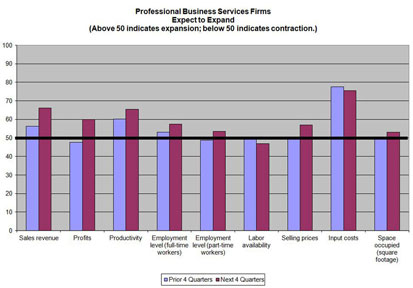“Business as usual.”
That was the response of a small western Wisconsin professional business firm, and a decent summary of overall sentiment from a May survey of professional services firms conducted by the Federal Reserve Bank of Minneapolis and the Minnesota Department of Employment and Economic Development.
Over the past four quarters, professional services firms experienced slight growth, with increased sales and productivity (see chart). However, profits were hurt by lower selling prices and higher input costs, employment costs and space usage. The outlook for the next four quarters is positive, as sales prices and revenue are expected to increase. Employers also expect employment, productivity, input costs and profits to increase. They also expect their state’s economy to grow at a faster pace.
While firms may not be experiencing dramatic increases in performance, many factors that promote or otherwise suggest higher activity are showing expansion. Forty-three percent of firms reported increased sales versus 30 percent reporting decreases. More respondents also reported lower versus higher sales prices (21 percent and 20 percent, respectively). Employment has expanded modestly, with 23 percent experiencing an increase in full-time workers versus 17 percent seeing employment go down. Of the respondents, 35 percent reported increases in productivity.
Still, overall profits were down, with 38 percent of firms seeing lower profits compared with 33 percent reporting higher profits. One likely reason is higher costs, cited by 58 percent of respondents, while just 3 percent reported lower input costs. Compensation also increased; wages per worker increased 2 percent over the past year, and benefits increased 1.6 percent.
In general, these professional business firms seem to be optimistic about the future; over 48 percent and 41 percent of respondents believe sales and profits (respectively) will increase, compared with 16 percent who expect revenue to decrease and 21 percent who feel profits will decrease. More than half of respondents also anticipate higher input cost creep compared with just 2 percent expecting input costs to decrease. More are also expecting selling prices to increase versus decrease (24 percent to 10 percent) and productivity to improve (39 percent) rather than decline (8 percent). Total compensation in the coming year is also expected to tick slightly higher than the previous year.
The firms’ outlook for their state economy is upbeat; 37 percent expect increased overall employment and about half expect to see the same level of employment, and 41 percent of firms expect higher consumer spending. While corporate profits are expected to increase, 60 percent also expect higher inflation, with only 1 percent believing that inflation will decrease.
Ninth District Professional Business Services Survey Methodology — May 2012
Of the approximately 20,000 Ninth District professional business services firms (most firms in NAICS code 541), a stratified random sample of 2,200 businesses was drawn from the population. For each state, the population was stratified based on employment size; the sample includes 100 percent of establishments with more than 49 employees, 30 percent with 5 to 49 employees and 4 percent with fewer than 5 employees.
A postcard survey was mailed to each of the selected businesses. The mailing was sent in early May, and a second mailing was sent in mid-May to businesses that did not respond to the first mailing. A cutoff for survey responses was May 31. A total of 417 usable surveys were received, for a response rate of 20 percent.
Survey results were tabulated for all professional business services firms. The confidence interval for sampling error was calculated. The 95 percent confidence interval for the results is plus or minus 4.8 percentage points. Results are also subject to errors introduced by other factors, such as the wording of questions and differences between survey respondents and nonrespondents.
Note: The Minnesota Department of Employment and Economic Development produced and processed the surveys for Minnesota firms, and the Federal Reserve Bank of Minneapolis conducted the survey for manufacturers in Montana, North and South Dakota, Ninth District counties in western Wisconsin and the Upper Peninsula of Michigan.
Business Poll Results [xls]







